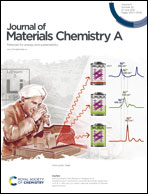Optimization of active layer morphology by small-molecule donor design enables over 15% efficiency in small-molecule organic solar cells†
Abstract
Molecular innovation is highly important to achieve highly efficient small-molecule organic solar cells (SMOSCs). Herein, we report two small-molecule donors, namely, B3T-T and B3T-P, which differ only in their conjugated side chains: the former with a thienyl group and the latter with a phenyl unit. Surprisingly, both small-molecule donors show distinct electron density distribution and electrostatic potential along the conjugated backbone. B3T-P has a much higher dipole moment (0.920 D) than that of B3T-T (0.237 D). In SMOSCs, the B3T-T:BO-4Cl-based device shows a decent power conversion efficiency (PCE) of 11.1%. In contrast, the B3T-P:BO-4Cl-based device gives an outstanding PCE of 15.2%, which is one of the highest values among SMOSCs. Compared to the B3T-P-based device, although the B3T-T-based device has a large enough driving force for exciton separation and an extremely low non-radiative recombination voltage loss (0.168 V) for achieving high open-circuit voltage, the large domain size (63 nm) and low domain purity in the B3T-T:BO-4Cl-based device results in a relatively low short-circuit current density and fill factor, thus giving a low PCE. This result may pave the way to rationally design SM donors for highly efficient SMOSCs.



 Please wait while we load your content...
Please wait while we load your content...